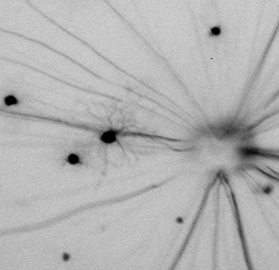Norrin treatment improves ganglion cell survival in an oxygen-induced retinopathy model of retinal ischemia. In Experimental Eye Research (2017), accepted, in press.

Highlights
• Norrin treatment accelerates recovery of the mouse OIR model from ischemic insult.
• SD-OCT can compare NFL/GCL (nerve fiber layer/ganglion cell layer) thickness in vivo.
• Norrin treatment counters thinning of the NFL/GCL in the mouse OIR model.
• Norrin treatment increases the surviving population density of RGCs in OIR retinas.
This paper is one of the first to use the in vivo imaging methods of intrinsic fluorescence with a transgenic mouse strain to see individual ganglion cells in the living mouse eye, and to even follow their morphology over a period of many days in the mouse model of oxygen-induced retinopathy. This was done with a Phoenix Research Labs‘ system, in this case the Micron-III version of their imaging system. We used a light filter set recommended by Phoenix to image yellow-fluorescent protein (YFP). Axons and dentrites could be seen on single cells in anesthetized mice. Amazing!
We also employed SD-OCT (Spectral Domain – Optical Coherence Tomography) to capture 3D structural records of the mouse retina and then to measure the changes in thickness of the very thin Nerve Fiber Layer / Ganglion Cell Layer (NFL/GCL).
The ability to use these imaging systems in vivo, which are also used in clinical analysis of the Human retina, enables us to see disease processes as they progress and to use far fewer mice to get the answers to research questions. In this case we were testing the ability of Norrin (Norrie’s Disease Protein) to be used to help avascular regions of retina recover their vasculature more quickly and improve the survival of RGCs (retinal ganglion cells) from the stress of low oxygen. RGCs are the cells that form our optic nerves. Millions of RGCs per eye have axons that extend all the way into connections with our brain. This bundle of a million “wires”, or axons, is the optic nerve.
Our research here and that of other laboratories suggest that Norrin and other agents might have use to maintain a better vasculature in diseases where the blood vessels and capillaries are damaged, such as ROP, Diabetic Retinopathy and AMD.
